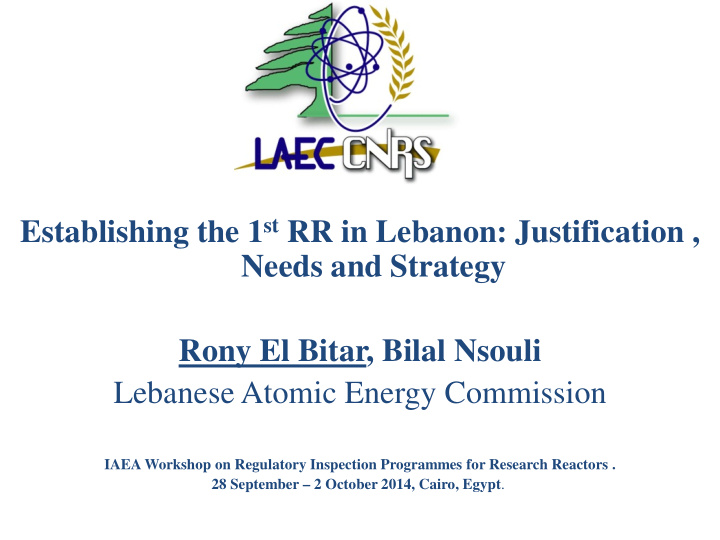



Establishing the 1 st RR in Lebanon: Justification , Needs and Strategy Rony El Bitar, Bilal Nsouli Lebanese Atomic Energy Commission IAEA Workshop on Regulatory Inspection Programmes for Research Reactors . 28 September – 2 October 2014, Cairo, Egypt .
Lebanon country profile Total Area: 10452 Km 2 Sea Port: Beirut Coastline: 220 Km Population: 3,578,036 (July 2000 est.) Climate: Mediterranean. Languages: Arabic (official), French, English.
Establishment of the LAEC Mandate, Function and Responsibilities The LAEC was established in 1996 with the full support and assistance of the IAEA LAEC mandate : Encourage and develop the peaceful use of Atomic Energy in the country and • spread the Culture of Safety and Security of Radiation Sources. Fulfill the technical requirements of ratified conventions between Lebanon and • IAEA. Establish the national infrastructure for radiation protection and prepare the • necessary legislations for protecting the public, workers and environment against ionizing radiation. Strengthening regulatory capabilities and regulatory infrastructure, and • Establishment of the necessary safety infrastructure to build our first research reactor. Developing Human Resources for Nuclear Technologies. •
Justification (Why a RR?) Create a national research team in the field of nuclear applications /reactor physics: coordinated and supported by the CNRS (new mandate by law 2008) Initiate a synergy between concerned researchers and create a good research atmosphere in the field of fundamental and applied nuclear physics Build and develop national capacities in the field of nuclear reactor for any possible development in the future Follow the trend of socio economical development via nuclear program in the nuclear renaissance era and put the country on the regional map in this field
Needs and Issues : Choice of the RR type Potential use (NAA, PGNAA, ND) Elemental characterization and quantification in various kind of samples (environment, geology, agriculture, biology, archeology, interstellar, materials science, forensic) Neutron diffraction including reflectometry for surface and thin films application Education and training in basic sciences and technology HRD for nuclear technology and applications
Stakeholders, Potential Allies and Impacted Domains Forensic Environment Education/Training Research Reactor Geology Biology/pharmaceutics Archaeology Agriculture
Advantages of LPR’s :MNSR Low capital cost 5-10M$ project • Low operating cost • High Safety • Simple to operate • Less restrictive containment and sitting requirements • Location at universities • Low fuel burn-up (no need for refueling) • Long operation times per year (short maintenance time) • Irradiated samples are not highly radioactive • Fewer handling restrictions are required • Administrative procedures may be less stringent (political issues) • Long lifetime of the RR due to less ageing effects •
Status and progress of on-going preparatory activities . • On-going TC project to start the 1 st RR in the country “Studying the Feasibility of Establishing a Nuclear Research Reactor and Developing Human Resources for Nuclear Technologies”. • Preparing Pre-project assessment report and preliminary strategic plan. • National Seminars : National Seminar on Establishment of a New Research Reactor, Beirut 25-29 October 2010. – National workshop on methodology for Research Reactor site evaluation and review of proposed – site options, Beirut, 13 - 14 December 2012 .
Thanks for you attention
Recommend
More recommend